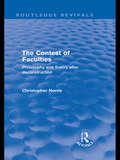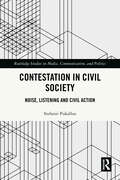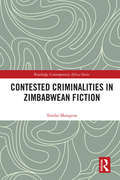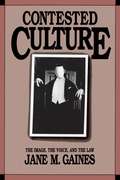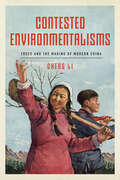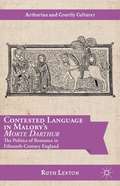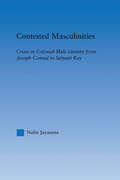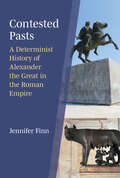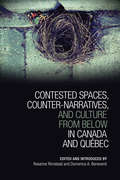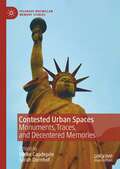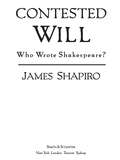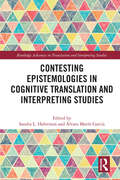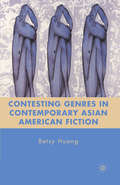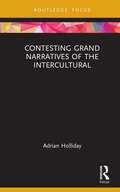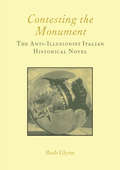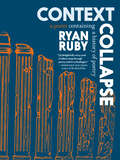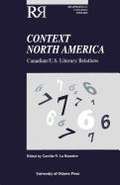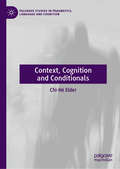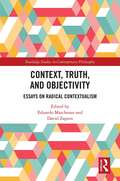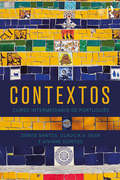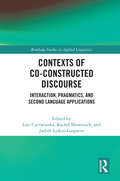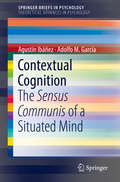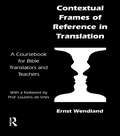- Table View
- List View
Contest of Faculties: Philosophy and Theory after Deconstruction (Routledge Revivals)
by Christopher NorrisThis Routledge Revival, first published in 1985, gives detailed attention to the bearing of literary theory on questions of truth, meaning and reference. On the one hand, deconstruction brings a vigilant awareness of the figural and narrative tropes that make up the discourse of philosophic reason. On the other it insists that argumentative rigour cannot be divorced from the kind of close reading that has come to characterize literary theory in its more advanced or speculative forms. This present-day ‘contest of faculties’ has large implications for philosophers and critics, many of whom will welcome the reissue of such a clear-headed statement of the impact of deconstruction.
Contestation in Civil Society: Noise, Listening and Civil Action (Routledge Studies in Media, Communication, and Politics)
by Stefanie PukallusContestation in Civil Society looks at the dynamic relationship between noise, listening and civil action as the key to understanding how societies communicatively make decisions about their internal and external boundaries.By focusing on the three components of noise, listening and civil action, the book moves attention away from an exclusive focus on what is being communicated – the communicator, the statement, the speech and so on. It argues that what is being communicated – the noise – does not lead in and of itself to civil action but rather that the audience – the listeners – plays a crucial role in determining what the noise means, whether it is judged legitimate or not and whether any civil action should be taken.Exploring how the relationship between noise, listening and civil action plays out within the context of contestation will interest academics and scholars of political studies, political philosophy, communication, sociology, media and cultural studies.
Contested Criminalities in Zimbabwean Fiction (Routledge Contemporary Africa)
by Tendai MangenaThis book addresses the ways in which writers deploy the trope of contested criminality to expose Zimbabwe's socially and politically oppressive cultures in a wide range of novels and short stories published in English between 1994 and 2016. Some of the most influential authors that are examined in this book are Yvonne Vera, Petina Gappah, NoViolet Bulawayo, Brian Chikwava, Christopher Mlalazi, Tendai Huchu and Virginia Phiri. The author uses the Zimbabwean experience to engage with critical issues facing the African continent and the world, providing a thoughtful reading of contemporary debates on illegal migration, homophobia, state criminality and gender inequalities. The thematic focus of the book represents a departure from what Schulze-Engler notes elsewhere as postcolonial discourse’s habit of suggesting that the legacies of colonialism and the predominance of the ‘global North’ are responsible for injustice in the Global South. Using the context of Zimbabwe, it is shown that colonialism is not the only image of violence and injustice, but that there are other forms of injustice that are of local origin. Throughout the book, it is argued that in speaking about contested criminalities, writers call attention to the fact that laws are violated, some laws are unjust and some crimes are henceforth justified. In this sense crime, (in)justice and the law are portrayed as unstable concepts.
Contested Culture
by Jane M. GainesJane M. Gaines examines the phenomenon of images as property, focusing on the legal staus of mechanically produced visual and audio images from popular culture. Bridging the fields of critical legal studies and cultural studies, she analyzes copyright, trademark, and intellectual property law, asking how the law constructs works of authorship and who owns the country's cultural heritage.
Contested Environmentalisms: Trees and the Making of Modern China
by Cheng LiFor decades, tree planting and forestry have been pivotal to Chinese environmentalism. During the Mao era, while forests were razed to fuel rapid increases in industrial production, the "Greening the Motherland" campaign promoted conservationist tree-planting nationwide. Contested Environmentalisms explores the seemingly contradictory rhetoric and desires of Chinese conservation from the early twentieth century through to the present. Drawing on literary, cinematic, scientific, archival, and digital media sources, Cheng Li investigates the emergence, evolution, and devolution of Chinese conservationist ideas. Combining literary, historical, and environmental studies approaches, he shows that these ideas acquired their value and assumed their power precisely because of their malleability and adaptability. Li historicizes authoritarian environmentalism and probes the global-local dynamics underlying conservationist ideas that energize environmental impulses in China. Examining ethnic borderlands, the Beijing political center, and China's growth on the world stage, this book demonstrates the strength of Chinese environmentalism to adapt and survive through tumultuous change lies in what seems to be a weakness: its inconsistency and contestation.
Contested Language In Malory’s Morte Darthur
by Ruth LextonMalory's Morte Darthur, which transformed the sprawling thirteenth-century French Vulgate Cycle romances for fifteenth-century English readers, is often seen as the culmination of the medieval Arthurian tradition and a consolidation of Arthur's reputation as a perfect chivalric ruler. Examining Malory's political language, this study challenges the accepted view of Arthur's kingship and the role of the Round Table fellowship. Considering a range of historical and political sources, Ruth Lexton suggests that Malory used a specific lexicon to engage with contemporary problems of kingship and demonstrates that the Morte interrogates the collapse of the English monarchy during the Wars of the Roses. .
Contested Masculinities: Crises in Colonial Male Identity from Joseph Conrad to Satyajit Ray (Literary Criticism and Cultural Theory)
by Nalin JayasenaExploring how English masculinity - that was so contingent on the relative health of the British imperial project - negotiated the decline and ultimate dissolution of the empire by the middle of the twentieth century, this book argues that by defining itself in relation to indigenous masculinity, English masculinity began to share a common idiom with its colonial other. The rhetoric of indigenous masculinity, therefore, both mimicked and departed from its metropolitan counterpart. The study combines an interdisciplinary approach with a focus that is not limited to a single colonial society but ranges from colonial Bengal, Burma, Borneo and finally to colonial Australia.
Contested Pasts: A Determinist History of Alexander the Great in the Roman Empire
by Jennifer FinnTaking as a key turning point the self-fashioning of the first Roman emperor Augustus, author Jennifer Finn revisits the idea of “universal history” in Polybius, Justin, and Diodorus, combined with the Stoic philosophy of determinism present in authors like Plutarch and Arrian. Finn endeavors to determine the ways in which Roman authors manipulated narratives about Alexander’s campaigns—and even other significant events in Mediterranean history—to artificially construct a past to which the Romans could attach themselves as a natural teleological culmination. In doing so, Contested Pasts uses five case studies to reexamine aspects of Alexander’s campaigns that have received much attention in modern scholarship, providing new interpretations of issues such as: his connections to the Trojan and Persian wars; the Great Weddings at Susa; the battle(s) of Thermopylae in 480 BCE and 191 BCE and Alexander's conflict at the Persian Gates; the context of his “Last Plans”;” the role of his memory in imagining the Roman Civil Wars; and his fictitious visit to the city of Jerusalem. While Finn demonstrates throughout the book that the influence for many of these narratives likely originated in the reign of Alexander or his Successors, nevertheless these retroactive authorial manipulations force us to confront the fact that we may have an even more opaque understanding of Alexander than has previously been acknowledged. Through the application of a mnemohistorical approach, the book seeks to provide a new understanding of the ways in which the Romans—and people in the purview of the Romans—conceptualized their own world with reference to Alexander the Great.
Contested Spaces, Counter-narratives, and Culture from Below in Canada and Québec
by Roxanne Rimstead Domenic A. BeneventiThis collection explores strategies of reading space and conflict in Canadian and Québécois literary and cultural performances. How do literary texts and popular cultural performances produce and contest spatial practices? What is the role of the nation, the city, the community, and the individual subject in reproducing space, even during times of global hegemony and neocolonialism? In what ways do marginalized individuals and communities represent, contest, or appropriate spaces through counter-narratives and expressions of culture from below? And how does space itself shape conflict, counter-memory, and culture from below? Focusing on contestation instead of harmony and consensus, Contested Spaces disturbs the idealized space of Canadian multicultural pluralism to carry literary analysis and cultural studies into spaces often undetected and unforeseen; Contested Spaces exposes geographies of exclusion and difference such as flophouses and "slums," shantytowns and urban alleyways, underground spaces and peep shows, inner city urban parks as experienced by minority ethnics, the poor, women, social activists, Indigenous people, and Francophones in Canada. These essays are the product of sustained and high-level collaboration across French and English academic communities in Canada to facilitate theoretical exchange on the topic of space and contestation, to expose geographies of exclusion, and to generate new spaces of hope in the spirit of pioneering work by Henri Lefebvre, Michel Foucault, Michel de Certeau, Doreen Massey, David Harvey, and other more recent theorists of space.
Contested Urban Spaces: Monuments, Traces, and Decentered Memories (Palgrave Macmillan Memory Studies)
by Sarah Dornhof Ulrike CapdepónThis book takes the urban space as a starting point for thinking about practices, actors, narratives, and imaginations within articulations of memory. The social protests and mobilizations against colonial statues are examples of how past injustice and violence keep on shaping debates in the present. Following an interdisciplinary approach, the contributions to this book focus on the in/visibility and affective power of monuments and traces through political, activist, and artistic contestations in different geographical settings. They show that memories are shaped in contact zones, most often in conflict and within hierarchical social relations. The notion of decentered memory shifts the perspective to relationships between imperial centers and margins, remembrance and erasure, nationalistic tendencies and migration. This plurality of connections emerges around unfinished histories of violence and resistance that are reflected in monuments and traces.
Contested Will: Who Wrote Shakespeare?
by James ShapiroFor more than two hundred years after William Shakespeare's death, no one doubted that he had written his plays. Since then, however, dozens of candidates have been proposed for the authorship of what is generally agreed to be the finest body of work by a writer in the English language. In this remarkable book, Shakespeare scholar James Shapiro explains when and why so many people began to question whether Shakespeare wrote his plays. Among the doubters have been such writers and thinkers as Sigmund Freud, Henry James, Mark Twain, and Helen Keller. It is a fascinating story, replete with forgeries, deception, false claimants, ciphers and codes, conspiracy theories--and a stunning failure to grasp the power of the imagination. As Contested Will makes clear, much more than proper attribution of Shakespeare's plays is at stake in this authorship controversy. Underlying the arguments over whether Christopher Marlowe, Francis Bacon, or the Earl of Oxford wrote Shakespeare's plays are fundamental questions about literary genius, specifically about the relationship of life and art. Are the plays (and poems) of Shakespeare a sort of hidden autobiography? Do Hamlet, Macbeth, and the other great plays somehow reveal who wrote them? Shapiro is the first Shakespeare scholar to examine the authorship controversy and its history in this way, explaining what it means, why it matters, and how it has persisted despite abundant evidence that William Shakespeare of Stratford wrote the plays attributed to him. This is a brilliant historical investigation that will delight anyone interested in Shakespeare and the literary imagination.
Contesting Epistemologies in Cognitive Translation and Interpreting Studies (Routledge Advances in Translation and Interpreting Studies)
by Sandra L. Halverson Álvaro Marín GarcíaThis dynamic collection synthesizes and critically reflects on epistemological challenges and developments within Cognitive Translation and Interpreting Studies, problematizing a range of issues. These critical essays provide a means of encouraging further development by grounding new theories, stances, and best practices. The volume is a clear marker of a maturing discipline, as decades of empirical study and methodological innovation provide the backdrop for critique and debate. The volume exemplifies tendencies toward convergence and difference, while at the same time pushing against disciplinary boundaries and structures. Constructs such as expertise and process are explored, and different theories of cognition are brought to the table. A number of chapters consider what it might mean for translation to be a form of situated, or 4EA cognition, while others query interdisciplinary relationships of foundational importance to the field. Issues of methodology are also addressed in terms of their underlying philosophical assumptions and implications. This book will be of interest to scholars working at the intersection of translation and cognition, in such fields as translation studies, cognitive science, psycholinguistics, semiotics, and philosophy of science.
Contesting Genres in Contemporary Asian American Fiction
by Betsy HuangThis book examines the influence of genre on contemporary Asian American literary production. Drawing on cultural theories of representation, social theories of identity, and poststructuralist genre theory, this study shows how popular prose fictions have severely constrained the development of Asian American literary aesthetics.
Contesting Grand Narratives of the Intercultural (Routledge Focus on Applied Linguistics)
by Adrian HollidayContesting Grand Narratives of the Intercultural uses an autoethnographic account of the author’s experience of living in Iran in the 1970s to demonstrate the constant struggle to prevent the intercultural from being dominated by essentialist grand narratives that falsely define us within separate, bounded national or civilisational cultures. This book provides critical insight that: DeCentres how we encounter and research the intercultural by means of a third-space methodology Recovers the figurative, creative, flowing, and boundary-dissolving power of culture Recognises hybrid integration which enables us the choice and agency to be ourselves with others in intercultural settings Demonstrates how early native-speakerism pulls us back to essentialist large-culture blocks. Aimed at students and researchers in applied linguistics, intercultural studies, sociology, and education, this volume shows how cultural difference in stories, personal space, language, practices, and values generates unexpected and transcendent threads of experience to which we can all relate within small culture formation on the go.
Contesting the Monument: The Anti-illusionist Italian Historical Novel
by Ruth Glynn"In the second half of the twentieth century, the Italian historical novel provided an unrivalled number of best sellers and publishing 'phenomena'. The success of the genre is closely related to a more general interest in revisiting the past in the light of a changed understanding of the nature, or philosophy, of history. This study aims to explore the particularly marked increase in the production and popularity of the historical novel in the period between the mid-1960s and the early 1990s, with reference to current debates on the nature of history. It presents a theoretical framework which establishes the centrality of philosophy of history to the development of the genre. The employment of this framework opens out the discussion of literary change to the consideration of historiographical developments and wider critical debate. The theoretical insights gained inform the close textual analysis provided in the chapters dealing with novels written by five of Italy's foremost contemporary writers: Leonardo Sciascia, Vincenzo Consolo, Sebastiano Vassalli, Umberto Eco, and Luigi Malerba."
Context Clues: Reading Comprehension Activities (Reading Level 3.5 - 5.0)
by EdupressReinforce critical reading skills with a diverse range of classroom activities! Detailed teacher instruction pages. Leveled reading passages and reproducible activities. Individual, small-group and whole-class activities.
Context Collapse: A Poem Containing a History of Poetry
by Ryan RubyLiterary critic Ryan Ruby uncovers the secret history of poetry in a mock-academic verse essay filled with wit and wisdom.One of Publishers Weekly's Best Books of 2024Prophet. Entertainer. Courtier. Criminal. Revolutionary. Critic. Scholar. Nobody. Epic in sweep, Context Collapse is the secret history of the poet—from Bronze Age Greece and Renaissance Italy to the cafés of Grub Street and the Latin Quarter, from the creative writing departments of the American Midwest to the boardrooms of Silicon Valley. Cheekily introducing academic discourse, media studies, cybersemiotics, literary sociology, and heterodox economics into his blank verse study of poetry, Ruby traces the always delicate dance between poets, their publishers, and their audiences, and shows how, time and time again, the social, technological, and aesthetic experiments that appear in poetic language have prefigured radical changes to the ways of life of millions of people. It is precisely to poets to whom we ought to turn to catch a glimpse, as Shelley once put it, of the &“gigantic shadows futurity casts on the present.&”
Context North America: Canadian/U. S. Literary Relations
by Camille R. La BossiereThis book is a comparative study of Canadian and American literary relations that emphasizes the cultural and institutional contexts in which Canadian literature is taught and read.
Context, Cognition and Conditionals (Palgrave Studies in Pragmatics, Language and Cognition)
by Chi-Hé ElderThis book proposes a semantic theory of conditionals that can account for (i) the variability in usages that conditional sentences can be put; and (ii) both conditional sentences of the form ‘if p, q’ and those conditional thoughts that are expressed without using ‘if’. It presents theoretical arguments as well as empirical evidence from English and other languages in support of the thesis that an adequate study of conditionals has to go beyond an analysis of specific sentence forms or lexical items. The resulting perspective on conditionals is one in which conditionality is located at a higher level than that of the sentence; namely, at the level of thought. The author argues that it is only through adopting such a perspective, and with it, a commitment to context-dependent semantics, that we can successfully represent conditional utterances as they are used and understood by ordinary language users. It will be of interest to students and scholars working on the semantics of conditionals in the fields of linguistics (especially semantics and pragmatics) and philosophy of language.
Context, Truth and Objectivity: Essays on Radical Contextualism (Routledge Studies in Contemporary Philosophy)
by Eduardo Marchesan David ZaperoThe claim according to which there is a categorial gap between meaning and saying – between what sentences mean and what we say by using them on particular occasions – has come to be widely regarded as being exclusively a claim in the philosophy of language. The present essay collection takes a different approach to these issues. It seeks to explore the ways in which that claim – as defended first by ordinary language philosophy and, more recently, by various contextualist projects – is grounded in considerations that transcend the philosophy of language. More specifically, the volume seeks to explore how that claim is inextricably linked to considerations about the nature of truth and representation. It is thus part of the objective of this volume to rethink the current way of framing the debates on these issues. By framing the debate in terms of an opposition between "ideal language theorists" and their semanticist heirs on the one hand and "communication theorists" and their contextualist heirs on the other, one brackets important controversies and risks obscuring the undoubtedly very real oppositions that exist between different currents of thought.
Contextos: Curso Intermediario De Portugues
by Denise Santos Glaucia Silva Viviane GontijoContextos: Curso Intermediário de Português is an engaging and motivating course that takes learners from the intermediate to advanced level. The course allows students to systematically practise all four language skills as well as develop intercultural awareness. Each unit contains clear learning objectives linked to recognised standards as well as self-assessment checklists and review plans. This supports students to become autonomous learners by tracking their own progress and focusing on specific areas of difficulty. A companion website provides an interactive workbook with additional grammar and vocabulary practice to reinforce those within the book, as well as the audio to accompany the course. The course takes learners from the intermediate-low to advanced-low according to the ACTFL proficiency guidelines and from A2 to B2 according to the CEFR.
Contexts for Hawthorne: The Marble Faun and the Politics of Openness and Closure in American Literature
by Milton R. SternWhere does the Marble Faun fit in Hawthorne's canon?
Contexts of Co-Constructed Discourse: Interaction, Pragmatics, and Second Language Applications (Routledge Studies in Applied Linguistics)
by Lori CzerwionkaThis collection showcases cutting-edge developments in co-construction in discourse. Drawing on the pioneering work of Dale A. Koike, the volume contributes new understandings of how speakers jointly negotiate meanings, contexts, identities, and social positions in interaction. The volume is organized around three key themes in co-construction—co-constructed discourse, pragmatics in discourse, and teaching and assessment of discourse—and builds on the introductory chapter that situates the discussion on context and co-construction as fundamental to understanding meaning-making in interaction. Drawing on interdisciplinary perspectives across strands of linguistics and education, chapters explore both the contextual elements that frame co-construction processes and the distinct dynamics between action and language use across a wide range of interactional contexts, including sports commentary, interviews, everyday conversation, classroom discourse, and digitally mediated settings. Taken together, the book highlights the impact of Koike’s contributions on existing research in pragmatics and discourse and exhibits the potential for her work to frame scholarship on emerging interactional contexts. This volume will be of particular interest to students and researchers in discourse studies, pragmatics, applied linguistics, second language studies, and language education, as well as those interested in interaction across diverse contexts.
Contextual Cognition: The Sensus Communis of a Situated Mind (SpringerBriefs in Psychology)
by Agustín Ibáñez Adolfo M. GarcíaThis Brief introduces two empirically grounded models of situated mental phenomena: contextual social cognition (the collection of psychological processes underlying context-dependent social behavior) and action-language coupling (the integration of ongoing actions with movement-related verbal information). It combines behavioral, neuroscientific, and neuropsychiatric perspectives to forge a novel view of contextual influences on active, multi-domain processes. Chapters highlight the models' translational potential for the clinical field by focusing on diseases compromising social cognition (mainly illustrated by behavioral variant frontotemporal dementia) and motor skills (crucially, Parkinson’s disease). A final chapter sets forth metatheoretical considerations regarding intercognition, the constant binding of processes triggered by environmental and body-internal sources, which confers a sensus communis to our experience. In addition, the book includes two commentaries written by external peers pondering on advantages and limits of the proposal. Contextual Cognition will be of interest to students, teachers, and researchers from the fields of cognitive science, neurology, psychiatry, neuroscience, psychology, behavioral science, linguistics, and philosophy.
Contextual Frames of Reference in Translation: A Coursebook for Bible Translators and Teachers
by Ernst WendlandBible translation theory and practice rightly tend to focus on the actual text of Scripture. But many diverse, yet interrelated contextual factors also play an important part in the implementation of a successful translation program. The aim of this coursebook is to explore, in varying degrees of detail, a wide range of these crucial situational variables and potential influences, using a multidisciplinary approach to the task. Thus, in order to expand and enrich the field of vision, a progressive study of this complex process of intercultural, interlinguistic communication is carried out according to a set of overlapping sociocultural, organizational and situational cognitive orientations. These contextual factors provide a broader frame of reference for analyzing, interpreting and communicating the original Scriptures in a completely new, contemporary setting of transmission and reception. The three dimensions are then applied in a practical way to explore the dramatic "throne-room" vision of the Apostle John (Revelation 4-5) with reference to both the original Greek text and also a modern dynamic translation in Chewa, a southeastern Bantu language of Africa. A variety of exercises and assignments to stimulate critical and creative reflection as well as to illustrate the theoretical development of Contextual Frames of Reference is provided every step of the way. Not only is translation per se discussed, but the teaching and evaluation of translated texts and versions are also considered from several points of view in the final three chapters. An Appendix offers a foundational essay by Professor Lourens de Vries on the subject of primary orality and the influence of this vital factor in the crosscultural communication of the Bible.
